Experience the Spiritual Essence of Zhenru Temple in Shanghai
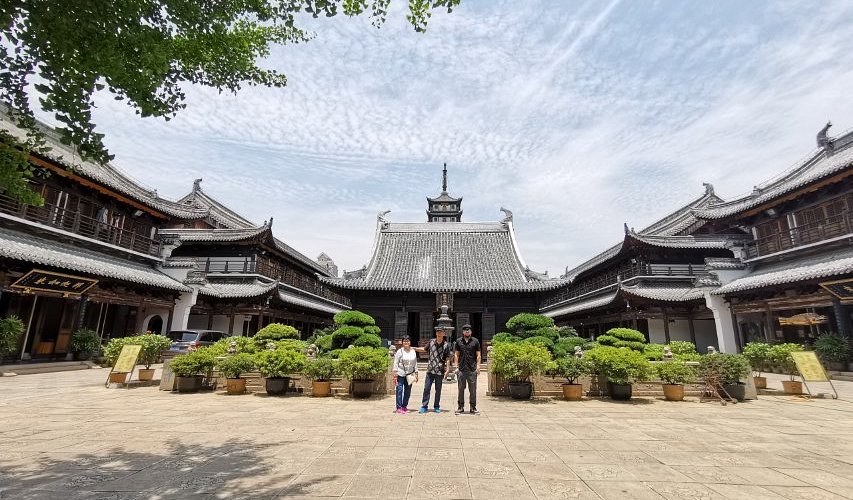
An Essential Guide to Visiting Zhenru Temple
In This Guide
- An Essential Guide to Visiting Zhenru Temple
- The Rich History and Legends of Zhenru Temple
- Main Highlights: What You Absolutely Can’t Miss
- Planning Your Visit: A Practical Guide
- Tickets: Prices, Booking, and Tips
- How to Get There: A Complete Transportation Guide
- Local Cuisine and Accommodation Nearby
- Frequently Asked Questions
- Final Thoughts on Your Trip
Discovering the Serenity of Zhenru Temple
Nestled in the bustling Putuo District of Shanghai, Zhenru Temple (真如寺) stands as a tranquil oasis steeped in history, beckoning travelers to explore its serene grounds. Established in 1320, this wooden temple is not only a testament to ancient architectural prowess but also a spiritual haven that resonates with the chants of resident monks and the whispers of the past.
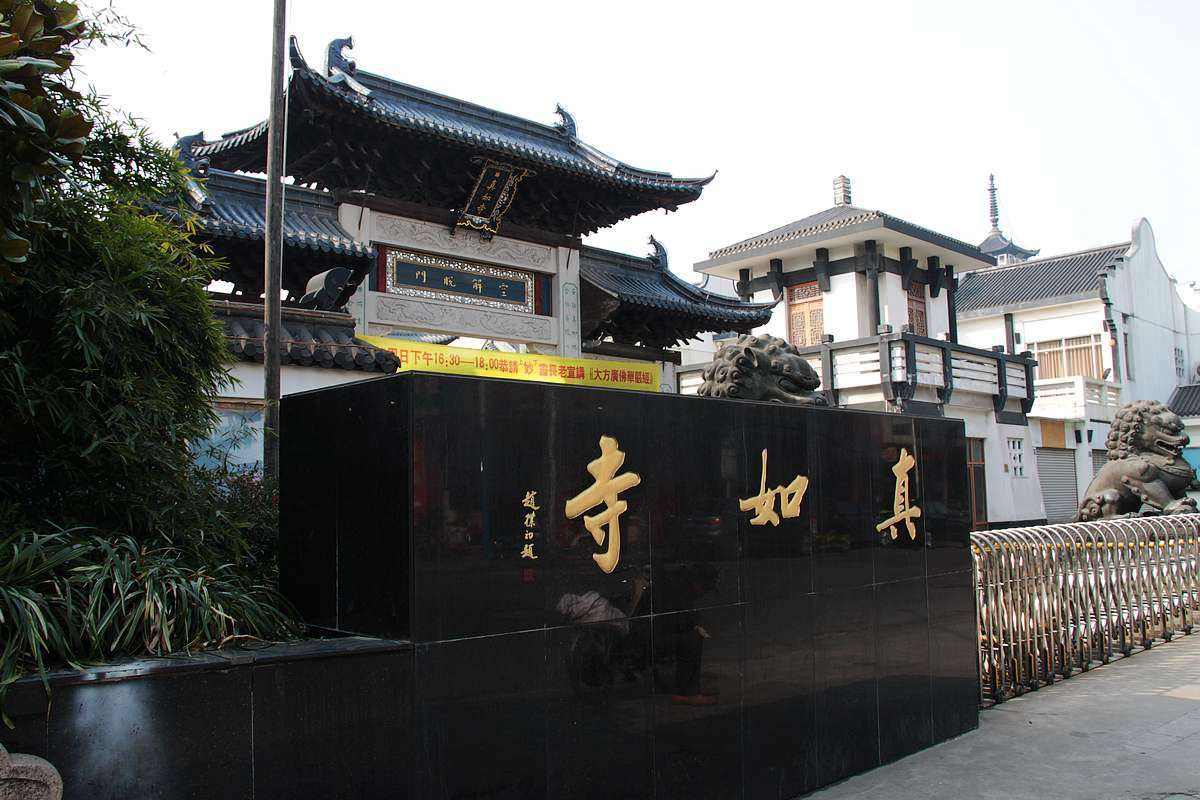
Zhenru Temple.
As you approach, the harmonious blend of nature and spirituality envelops you, inviting moments of contemplation and reflection. The meticulously maintained gardens, adorned with exquisite bonsai trees and ornamental shrubs, create a picturesque backdrop that enhances the temple’s contemplative atmosphere. Here, visitors can wander through the intricate halls, marvel at the stunning religious statues, and appreciate the architectural details that tell the story of centuries gone by.
Whether you are a history enthusiast, a spiritual seeker, or simply someone looking to escape the frenetic pace of modern life, Zhenru Temple offers a perfect half-day retreat. Allow yourself to be captivated by the beauty of the pagoda, the bell walkway, and the calming presence of the surrounding canal. With a modest entrance fee, you can immerse yourself in this sacred space, where the echoes of prayers and the gentle rustle of leaves create a symphony of peace.
Prepare to embark on a journey that transcends time and place, as Zhenru Temple invites you to pause, reflect, and connect with the profound tranquility that defines this historical gem.
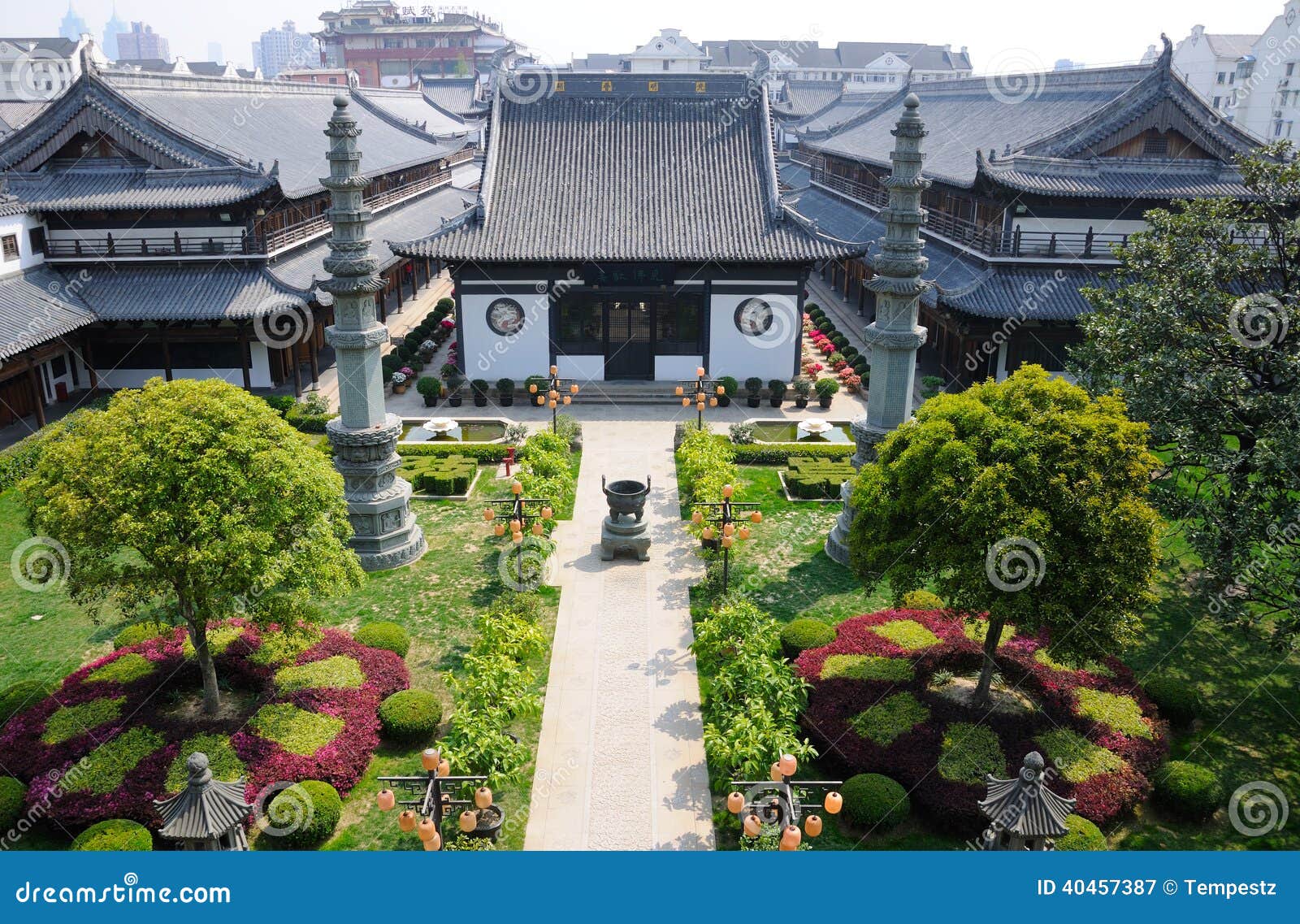
Zhenru Temple.
The Rich History and Legends of Zhenru Temple
Nestled in the heart of Shanghai’s Putuo District, Zhenru Temple (真如寺) is a serene sanctuary steeped in history and spirituality. Established in 1320 during the Yuan Dynasty, this wooden temple is a testament to the rich cultural heritage of China. With a history spanning over seven centuries, Zhenru Temple has not only withstood the test of time but has also become a focal point for both worshippers and tourists alike.
A Legacy of Spiritual Significance
The temple was initially built by a group of monks who sought to create a space dedicated to the practice of Buddhism. Over the centuries, Zhenru Temple has served as a vital hub for religious activities, attracting countless visitors for prayer and reflection. Its tranquil atmosphere is often enhanced by the soothing sounds of monks chanting—an experience that transports visitors to a realm of peace and contemplation.
Architectural Wonders
Zhenru Temple is renowned for its stunning architectural features. The temple complex is adorned with intricate carvings and stately structures that reflect traditional Chinese design. Key highlights include the graceful pagoda that rises majestically against the skyline and the exquisite bell walkway that enchants visitors with its melodic tones. Each hall within the temple is dedicated to different deities, showcasing some of the most revered religious statues in the area.

Zhenru Temple.
The gardens surrounding the temple are equally captivating, meticulously maintained with bonsai trees and ornamental shrubs that create a harmonious blend of nature and spirituality. Visitors often take the time to wander through these gardens, allowing themselves to be enveloped by the serenity of their surroundings.
Legends and Lore
As with many historical sites in China, Zhenru Temple is rich with legends that add to its allure. One popular tale speaks of a Buddhist monk who discovered a hidden treasure within the temple grounds—an ancient scroll said to contain profound wisdom. This discovery is believed to have contributed to the temple’s reputation as a place of enlightenment.
Another legend recounts the story of a local villager who, after praying fervently at Zhenru Temple, experienced a miraculous healing. This event not only solidified the temple’s status as a sacred site but also inspired a wave of pilgrimages from nearby towns, each seeking solace and divine intervention.
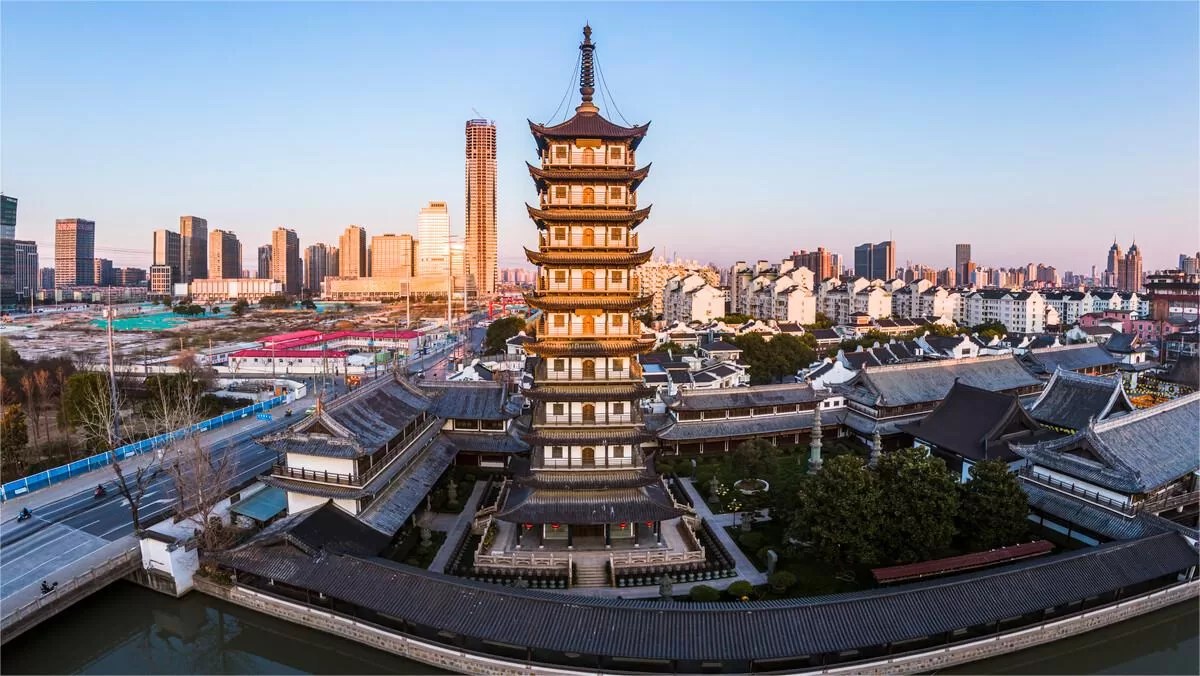
Zhenru Temple.
A Place for Reflection
For international travelers interested in Chinese history and culture, Zhenru Temple offers a unique glimpse into the spiritual heart of China. The temple’s peaceful ambiance invites visitors to spend time reflecting, writing, or simply “being” in the moment. Whether you are drawn by its architectural beauty, rich history, or sacred atmosphere, Zhenru Temple is a destination that promises an enriching experience.
Plan Your Visit
To fully appreciate the tranquility and historical significance of Zhenru Temple, allocate at least half a day for your visit. The small entrance fee grants access to the temple grounds, where you can explore its various halls and gardens. Be sure to check the temple’s opening hours, as it operates daily, welcoming all who seek a moment of peace amidst the bustling city.
Zhenru Temple is not just a monument of the past; it is a living testament to the enduring spirit of spirituality and community in China. As you wander its halls and gardens, you may find that the legends of Zhenru Temple continue to resonate in the hearts of those who visit, bridging the ancient with the contemporary in a harmonious embrace.
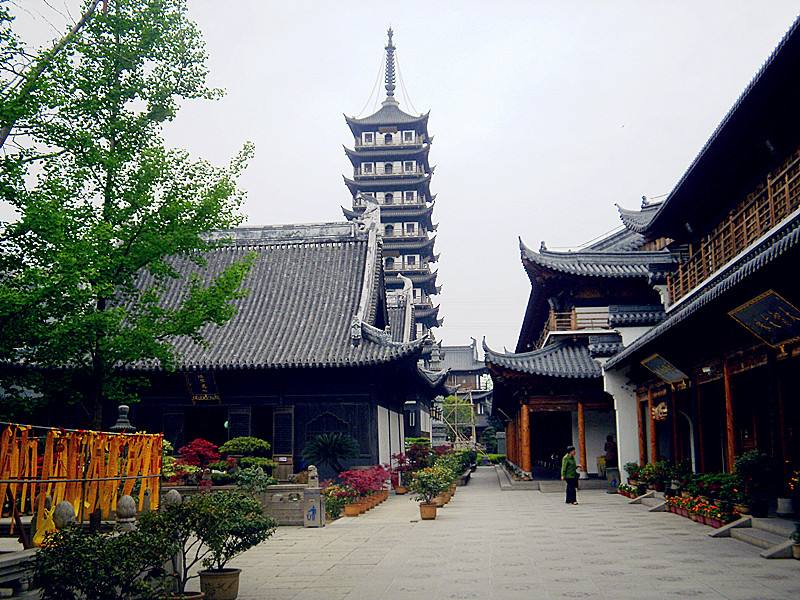
Zhenru Temple.
Main Highlights: What You Absolutely Can’t Miss
Discover the Unmissable Highlights of Zhenru Temple
Nestled in the heart of Shanghai’s Putuo District, Zhenru Temple (真如寺) is a serene sanctuary that beautifully blends history, architecture, and spirituality. Built in 1320, this wooden temple stands as a testament to China’s rich cultural heritage and offers visitors a peaceful retreat from the bustling city. Here’s what you absolutely can’t miss during your visit:
1. Architectural Marvels
The temple’s architecture is a stunning representation of traditional Chinese design. As you stroll through the grounds, take a moment to admire the intricate wooden structures adorned with intricate carvings and decorative motifs. The bell walkway, lined with ancient bells, creates a magical ambiance, especially as the soft sound resonates through the air. Don’t forget to snap photos of the majestic pagoda, which is not only visually striking but also embodies the spiritual essence of the temple.
2. Tranquil Atmosphere
Zhenru Temple is known for its zen-like atmosphere, perfect for those seeking tranquility. The gentle chants of monks can often be heard, enhancing the peaceful environment. Visitors have described the experience as sacred and reflective, making it an ideal location for contemplation or meditation. Take a seat amidst the lush gardens, with their meticulously maintained bonsai trees and ornamental plants, and allow yourself to just “be” in the moment.
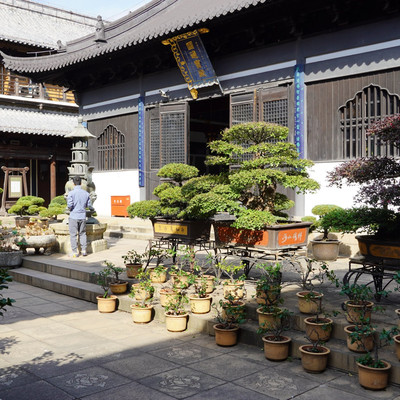
Zhenru Temple.
3. Spiritual Significance
As you explore the temple, pay close attention to the religious statues that grace its halls. Some of these statues are among the most precious in the area, representing various deities and figures from Buddhist tradition. Each hall serves a different purpose, offering spaces for prayer and reflection. Engage with the spiritual aspect of the temple by participating in a prayer session or simply observing the rituals that unfold.
4. Scenic Surroundings
The temple is beautifully situated along a serene canal, providing picturesque views and a perfect backdrop for leisurely walks. The natural beauty surrounding Zhenru Temple enhances its spiritual ambiance, inviting visitors to connect with nature. Take time to wander near the water’s edge, where you may spot local birds and wildlife, further enriching your experience.
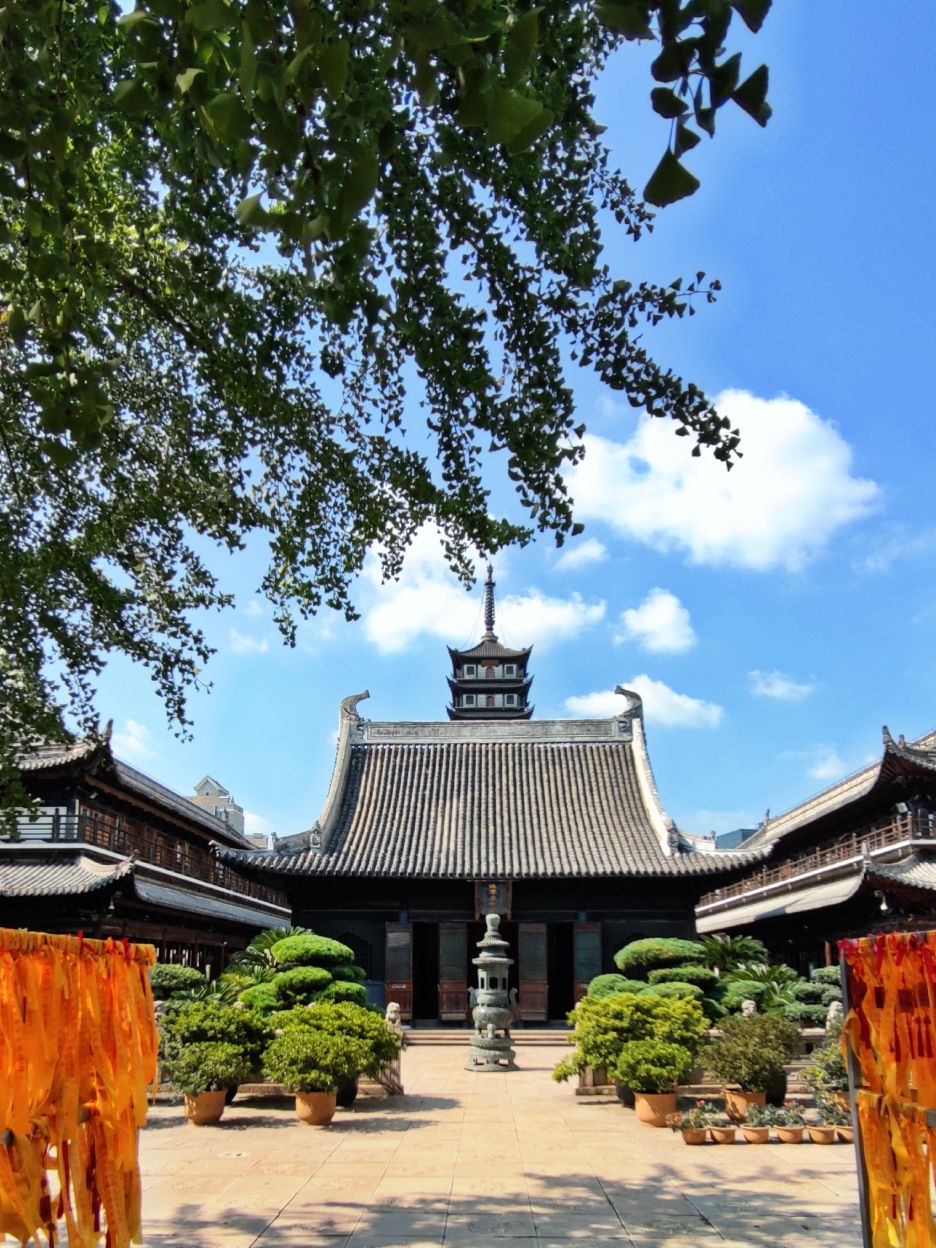
Zhenru Temple.
5. Unique Features
One of the unique highlights of Zhenru Temple is its large pigeon coop. During your visit, you might encounter these birds roaming freely around the temple grounds, adding a whimsical touch to the serene setting. This blend of nature and spirituality creates a dynamic atmosphere that is both refreshing and calming.
6. Practical Information
- Hours of Operation: Open daily from 7:55 AM to 4:04 PM.
- Entrance Fee: A small fee is charged at the gate, making it accessible for all visitors.
- Location: Easily reachable, the temple is just an 8-minute walk from Zhenru Station.
Conclusion
Zhenru Temple is more than just a historical site; it is a refuge that offers a glimpse into the profound depth of Chinese culture and spirituality. Whether you’re interested in architecture, history, or simply seeking a moment of peace, this temple is an essential stop on your Shanghai itinerary. Make sure to allocate at least half a day to fully immerse yourself in its beauty and tranquility.
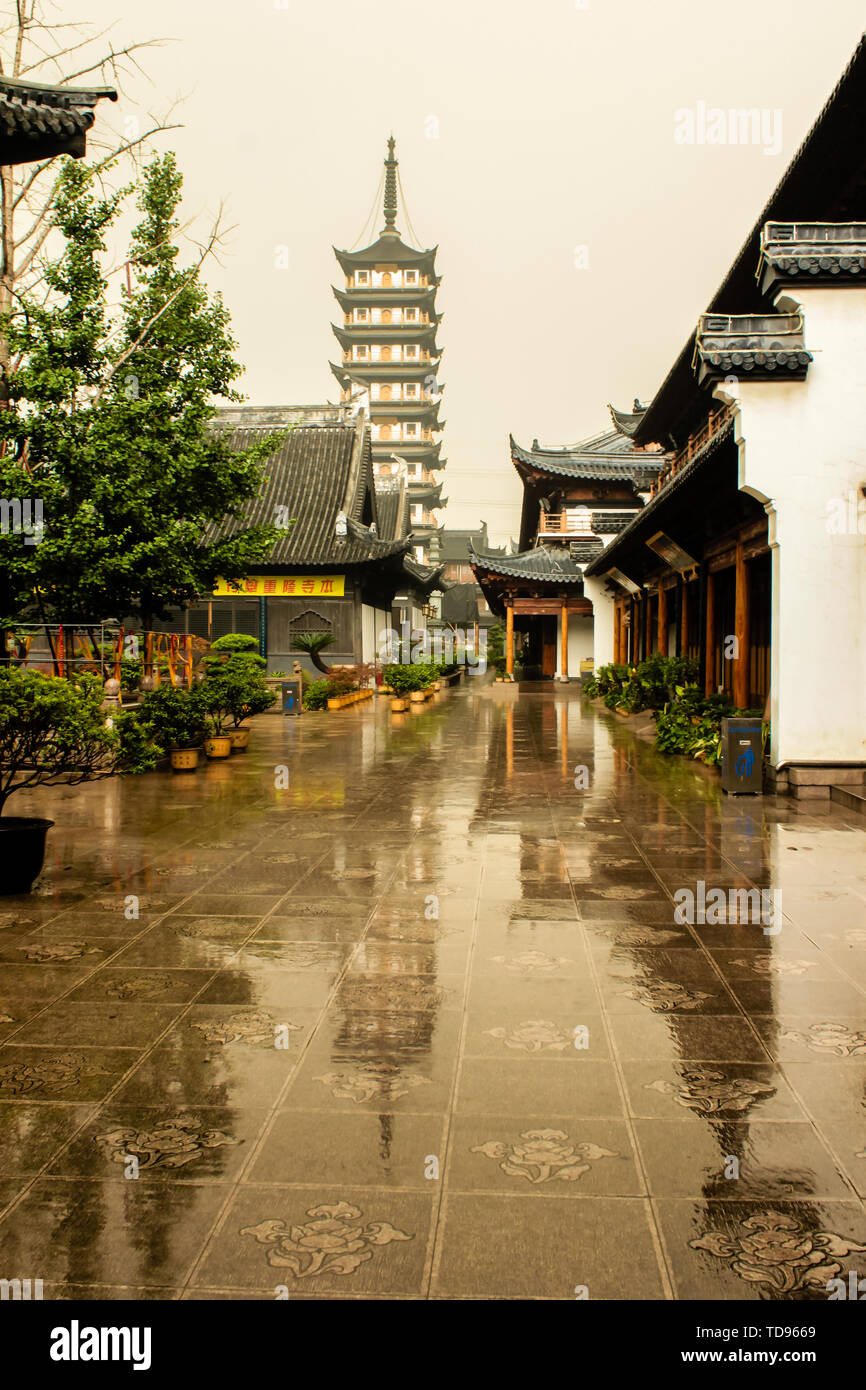
Zhenru Temple.
Planning Your Visit: A Practical Guide
Essential Information for Your Visit to Zhenru Temple
Nestled in the heart of Shanghai’s Putuo District, Zhenru Temple (真如寺) is a serene oasis that transports visitors back to its origins in the 14th century. This historic wooden temple, constructed in 1320, is not only a place of worship but also a beautiful example of traditional Chinese architecture set against a backdrop of tranquil gardens and waterways. Here’s everything you need to know to make the most of your visit.
Getting There
- Address: No.5 Houshanmen, Zhenru Town, Putuo District, Shanghai 200333, China.
- Public Transport: The nearest subway station is Zhenru Station on Line 3, which is about an 8-minute walk from the temple. Follow the signs to Houshanmen for easy navigation.
- Parking: If you’re driving, there are parking facilities nearby, but spaces can fill up quickly on weekends.
Opening Hours
- Daily: 7:55 AM – 4:04 PM
Note: It’s advisable to arrive early to enjoy the temple before the crowds and to experience the monks’ morning chants, which add a spiritual ambiance to the visit.
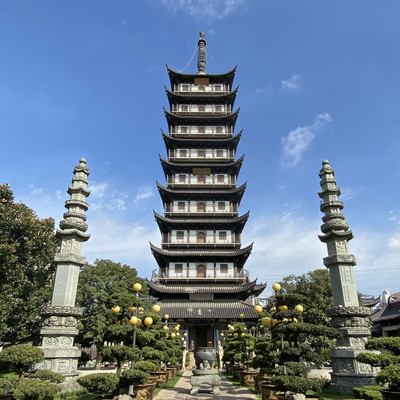
Zhenru Temple.
Entrance Fee
- A small entrance fee is charged at the gate, contributing to the temple’s maintenance. Be sure to carry some cash, as card payments may not be accepted.
What to Expect
- Architecture: Marvel at the intricate wooden structures and traditional designs. The temple features a stunning bell walkway, a serene pagoda, and beautifully maintained grounds with bonsai trees and ornamental bushes.
- Spiritual Experience: Engage in quiet contemplation or prayer in various halls dedicated to different deities. The atmosphere is peaceful, making it an ideal spot for reflection.
- Wildlife: Keep an eye out for the large pigeon coop on site; witnessing these birds in their natural environment adds a unique charm to the visit.
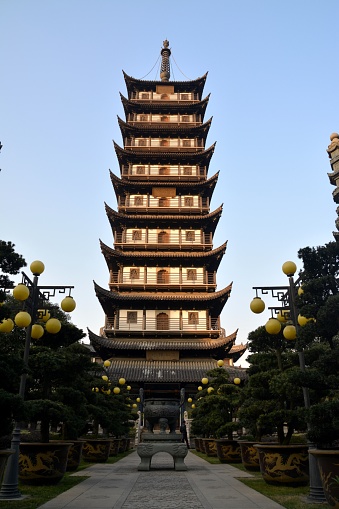
Zhenru Temple.
Tips for Your Visit
- Timing: Plan to spend at least half a day here to fully appreciate the architecture and gardens. Early mornings are particularly quiet and picturesque.
- Photography: Capture the beauty of the temple and its surroundings, but be respectful of the sacred space and those who are praying.
- Nearby Attractions: Consider visiting other nearby sites such as the Jade Buddha Temple or Jing’an Temple, both rich in history and culture, to enhance your Shanghai experience.
- Dining Options: After your visit, you’ll find several local restaurants nearby offering delicious seafood and traditional Chinese cuisine. A few options include Xin Jiu LongTang and ZhenRu Seafood Cheng, both within walking distance.
Final Thoughts
Zhenru Temple is more than just a historical site; it is a place where history, spirituality, and nature intertwine. Whether you’re seeking a peaceful retreat from the bustling city or a deeper understanding of Chinese culture and religion, this temple offers a unique and enriching experience. Remember to take your time, soak in the atmosphere, and allow yourself to be enveloped by the serenity that surrounds you.
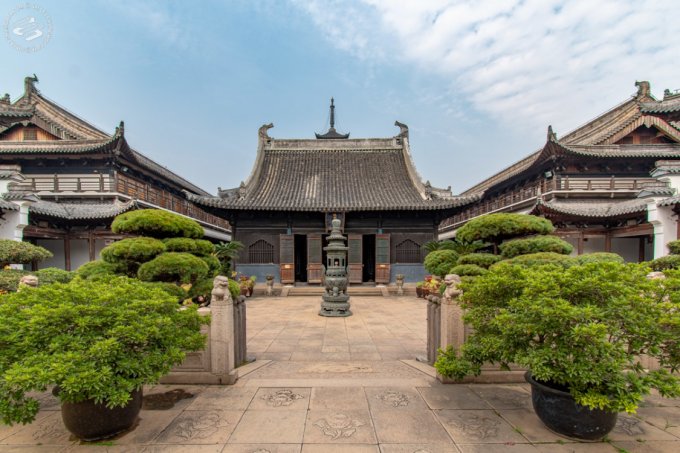
Zhenru Temple.
Tickets: Prices, Booking, and Tips
Visiting Zhenru Temple: Ticket Information and Tips
Nestled in the serene Putuo District of Shanghai, Zhenru Temple (真如寺) invites visitors to explore its tranquil grounds and rich history dating back to 1320. Before you embark on your journey to this architectural gem, here’s what you need to know about tickets, pricing, and tips for a fulfilling visit.
Admission Fees
- Standard Entry Fee: A small entrance fee is charged at the gate, which typically ranges from 10 to 20 RMB (approximately $1.50 to $3). This nominal fee helps maintain the temple grounds and supports its preservation efforts.
- Free Entry Days: Occasionally, the temple may offer free entry on special occasions or during cultural festivals. Be sure to check local announcements or the temple’s official website for updates.
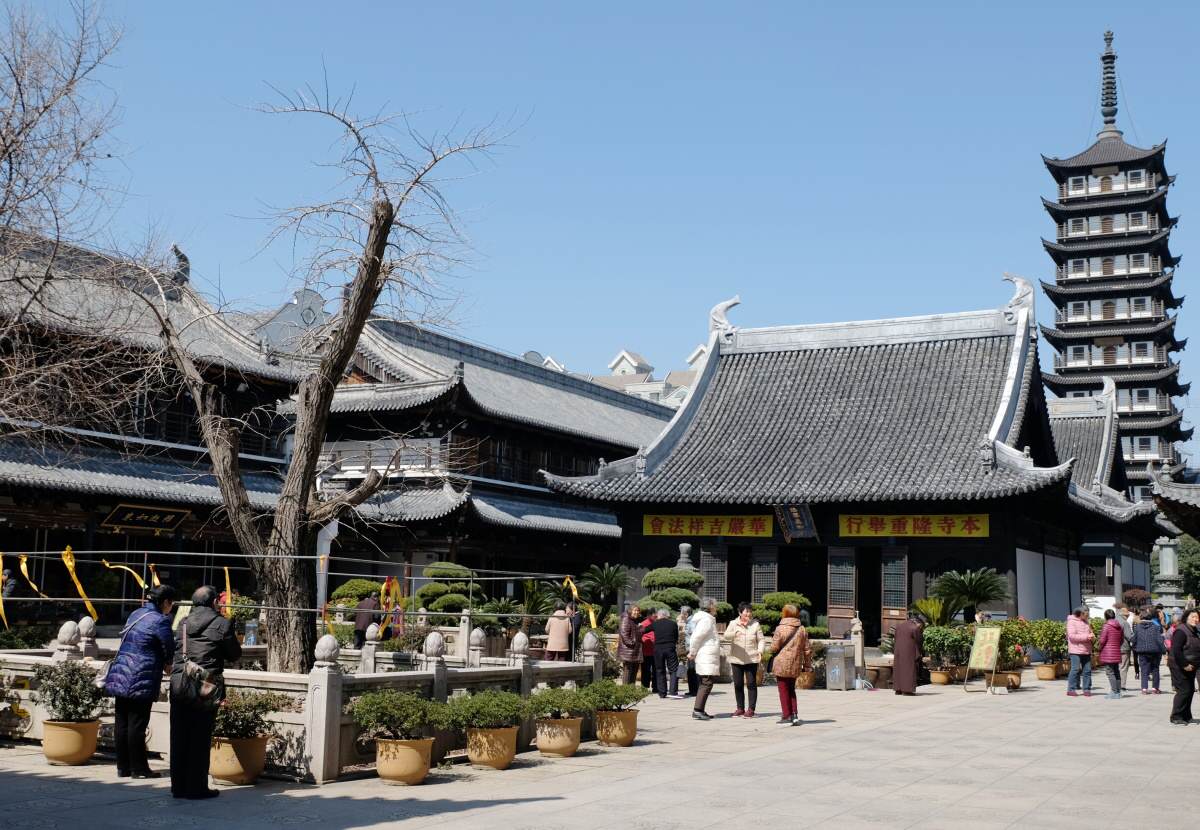
Zhenru Temple.
Booking Tickets
- On-site Purchase: Tickets are available for purchase directly at the temple entrance. There is no need for advance booking, making it convenient for spontaneous visits.
- Guided Tours: If you prefer a deeper understanding of the temple’s history and architecture, consider joining a guided tour. These can often be arranged through local travel agencies or online platforms specializing in Shanghai tours.
Operating Hours
- Daily Hours: Zhenru Temple is open from 7:55 AM to 4:04 PM. Plan your visit accordingly, as the temple closes promptly at 4:04 PM, allowing ample time to explore its stunning architecture and serene environment.
Tips for Your Visit
- Best Time to Visit: Early mornings are ideal for a peaceful experience, as the temple is less crowded, and the ambient sounds of monks chanting enhance the atmosphere.
- What to Bring: Consider bringing a notebook or sketchbook to capture the serene beauty of the temple’s gardens and structures. A camera is also recommended for stunning photographs of the ornate architecture and tranquil surroundings.
- Respect Local Customs: As Zhenru Temple is an active place of worship, maintain a respectful demeanor. Dress modestly and observe the local customs, especially in prayer areas.
- Allow Time to Reflect: Allocate at least half a day for your visit. The temple’s tranquil gardens, intricate bonsai trees, and reflective spaces invite contemplation and relaxation.
- Explore the Surroundings: After visiting the temple, consider exploring nearby attractions such as the Jade Buddha Temple or the charming Zhenru Ancient Town for a more comprehensive experience of the area.
Getting There
The temple is conveniently located within an 8-minute walk from Zhenru Subway Station (Line 13), making it easily accessible for travelers. Take a leisurely stroll through the neighborhood to fully immerse yourself in the local culture.
By planning your visit to Zhenru Temple with these insights in mind, you can ensure a memorable experience steeped in the rich history and serene beauty of this magnificent site. Enjoy your journey through time and tranquility!
How to Get There: A Complete Transportation Guide
Navigating to Zhenru Temple: Your Comprehensive Transportation Guide
Embarking on a journey to Zhenru Temple (真如寺) in Shanghai offers a unique opportunity to delve into the rich tapestry of Chinese history and culture. Nestled within the serene surroundings of the Putuo District, this temple, which dates back to 1320, is easily accessible through various modes of transportation. Here’s how you can reach this tranquil haven.
By Metro
The most efficient way to reach Zhenru Temple is via Shanghai’s expansive metro system:
- Line 11: Take Line 11 and disembark at Zhenru Station (真如站). The temple is approximately an 8-minute walk from the station.
- Exit the station and head towards Houshanmen Street; follow the signs to Zhenru Temple.
Tip: The Shanghai Metro operates from around 5:30 AM to 11 PM. Ensure to check the latest schedules and plan your return accordingly.
By Bus
If you prefer to travel by bus, several routes service the area around Zhenru Temple:
- Bus Routes:
- Route 45: Stops at Zhenru Temple.
- Route 93: Also provides access to the temple vicinity.
Consult local bus schedules for current timings, as they can vary throughout the day.
By Taxi or Ride-Sharing
For a more direct and comfortable experience, consider taking a taxi or using a ride-sharing app like Didi:
- Taxi Tips: Hailing a taxi in Shanghai is relatively straightforward. Simply show the driver the address: No.5 Houshanmen, Zhenru Town, Putuo District, Shanghai.
- Ride-Sharing: Apps like Didi are user-friendly and can help you navigate the city with ease. Just input your destination and await your ride.
By Bicycle
For the adventurous spirit, cycling offers a delightful way to explore the area around Zhenru Temple:
- Bike Rentals: Numerous bike-sharing services are available throughout Shanghai, making it easy to rent a bike and navigate the city at your own pace.
- Scenic Routes: Enjoy the beautiful canals and serene parks as you make your way to the temple.
Walking from Nearby Attractions
If you’re already exploring the Putuo District, consider a leisurely walk to Zhenru Temple. It’s in proximity to other notable attractions, allowing for a culturally enriching day:
- Zhenru Ancient Town: Just a half-mile away, this historic area is perfect for a stroll before or after visiting the temple.
Opening Hours and Admission
Zhenru Temple is open daily from 7:55 AM to 4:04 PM. A small entrance fee is charged at the gate, so be prepared to enjoy this sacred space fully.
Final Thoughts
Reaching Zhenru Temple is a seamless experience, whether you choose the metro, bus, taxi, or bike. Once you arrive, prepare to be enveloped by the tranquil atmosphere, stunning architecture, and the rich historical significance of this ancient site. Allow yourself to soak in the peaceful ambiance and perhaps even participate in a moment of reflection amidst the serene surroundings.
Local Cuisine and Accommodation Nearby
Culinary Delights and Cozy Stays Near Zhenru Temple
As you immerse yourself in the tranquility of Zhenru Temple, take the opportunity to explore the vibrant local cuisine and comfortable accommodations that the surrounding Putuo District has to offer. This area is a hidden gem for food lovers and travelers seeking a peaceful retreat.
Savor the Flavors
The neighborhood around Zhenru Temple is brimming with delightful dining options, primarily focusing on fresh seafood and authentic Chinese dishes. Here are some recommended eateries to satisfy your palate:
-
ZhenRu Seafood Cheng
Just a short walk from the temple, this restaurant specializes in a variety of seafood dishes, ensuring freshness and flavor. Don’t miss their signature crab and prawn dishes, which are local favorites. -
Xin Jiu LongTang
Located merely 274 feet away, this seafood spot offers a cozy atmosphere and a diverse menu. The grilled fish and steam pots are particularly popular, making it a great choice for a casual meal. -
Huang Yue Xuan
Another seafood establishment, Huang Yue Xuan boasts a reputation for high-quality dishes and excellent service. With a menu that includes everything from sashimi to stir-fried specialties, it’s perfect for those looking to experience the local marine bounty. -
Chao Long Restaurant
This Cantonese restaurant, known for its vibrant flavors and traditional recipes, is highly rated by locals. Their dim sum and roasted meats are must-tries, offering a true taste of regional cuisine. -
Tian ShangLai Restaurant
Located nearby, this eatery serves a mix of Chinese dishes, with a focus on fresh ingredients and traditional techniques. The ambiance is relaxed, making it a lovely spot to unwind after a day of exploring.
Comfortable Accommodations
After indulging in the local culinary scene, retreat to one of the nearby accommodations that offer comfort and convenience, allowing you to recharge for another day of exploration:
-
Zhe Hai Hotel
Situated within walking distance of Zhenru Temple, this hotel features well-appointed rooms and modern amenities. Guests appreciate the serene atmosphere and the attentive staff, making it an ideal choice for travelers seeking relaxation. -
The Green Tree Inn
This budget-friendly option provides a comfortable stay without skimping on quality. Located a short distance from the temple, it offers clean rooms and essential services, perfect for budget-conscious travelers. -
Shanghai Jialong Hotel
A bit further from the temple, this hotel offers a blend of comfort and convenience, with spacious rooms and a restaurant on-site. Its proximity to public transport makes it easy to explore other attractions in Shanghai. -
Hanting Express
Known for its consistent quality and affordability, Hanting Express is a reliable choice for travelers. With simple yet comfortable rooms, you’ll find this hotel caters well to both short and extended stays.
As you plan your visit to Zhenru Temple, consider indulging in the local seafood and experiencing the warmth of nearby accommodations. Each meal and night spent in the area will deepen your connection to Shanghai’s rich culture and history.
Frequently Asked Questions
Frequently Asked Questions about Zhenru Temple
1. What is Zhenru Temple?
Zhenru Temple (真如寺) is a historic wooden temple located in the Putuo District of Shanghai, built in 1320 during the Song Dynasty. It is renowned for its serene atmosphere, beautiful architecture, and rich spiritual heritage, making it a popular destination for both tourists and locals seeking reflection and tranquility.
2. What are the opening hours?
Zhenru Temple is open to visitors every day from 7:55 AM to 4:04 PM. It is advisable to arrive early to fully enjoy the peaceful ambiance and explore the temple grounds before it gets crowded.
3. Is there an entrance fee?
Yes, there is a small entrance fee charged at the gate. This fee helps maintain the temple and its beautiful gardens. The exact amount can vary, so it’s a good idea to check current prices upon arrival.
4. How do I get to Zhenru Temple?
The temple is easily accessible by public transportation. The nearest metro station is Zhenru Station, which is just an 8-minute walk from the temple. You can also take a taxi or use rideshare services for convenience.
5. What should I wear when visiting the temple?
Visitors are encouraged to dress modestly and respectfully when visiting Zhenru Temple. Comfortable clothing is advisable, as you may want to spend time sitting or walking around the peaceful grounds. Avoid wearing revealing attire to show respect for the sacred environment.
6. What can I expect to see inside the temple?
Inside Zhenru Temple, you will find several halls dedicated to various Buddhist deities, beautifully maintained gardens, and unique architectural features such as a bell walkway and a pagoda. Additionally, the temple is home to many precious religious statues and delightful bonsai trees, providing a perfect backdrop for contemplation and photography.
7. Are there any restrictions or rules for visitors?
Yes, as with many religious sites, visitors are expected to maintain a quiet demeanor, especially during prayer times. Photography is generally permitted, but it’s best to ask before taking pictures of monks or worshippers. Additionally, please refrain from touching any religious artifacts unless explicitly allowed.
8. Can I participate in any activities or rituals?
Visitors to Zhenru Temple often have the opportunity to witness traditional Buddhist ceremonies, including chanting by the monks. While participation in rituals may be limited for tourists, you are welcome to observe and reflect during these moments. If you’re interested, inquire with the temple staff about any specific ceremonies taking place during your visit.
Final Thoughts on Your Trip
As you conclude your visit to Zhenru Temple, take a moment to reflect on the serene beauty and rich history that this sacred place embodies. Nestled in the bustling city of Shanghai, this wooden temple, built in 1320, offers a peaceful respite from the frenetic pace of urban life. Here are a few final thoughts to encapsulate the essence of your experience:
Embrace the Tranquility
- Zen Atmosphere: The calming chants of the monks create a serene backdrop, inviting you to pause and immerse yourself in the moment. Take this opportunity to breathe deeply and appreciate the tranquility that surrounds you.
Appreciate the Architecture
- Historical Significance: With its impressive structures and meticulously maintained grounds, Zhenru Temple is a testament to centuries of architectural craftsmanship. The intricate designs and sacred statues speak volumes of the cultural heritage that has flourished here.
Connect with Nature
- Gardens and Bonsai: The well-kept ornamental gardens, featuring bonsai trees and lush greenery, provide a picturesque setting for quiet contemplation. Allow yourself to wander and connect with the natural beauty that complements the temple’s spiritual ambiance.
Reflect and Absorb
- Time to Contemplate: Whether you choose to sit in silence, jot down your thoughts, or simply observe the world around you, Zhenru Temple encourages reflection. This sacred space invites you to find your own moment of peace amid the hustle and bustle of modern life.
As you leave this historical site, carry with you the serene energy and profound insights gained from your visit. Zhenru Temple is not merely a destination; it is a sanctuary for the soul, a place where history and spirituality seamlessly intertwine. May your journey continue to inspire you to seek out moments of tranquility and reflection in your travels ahead.